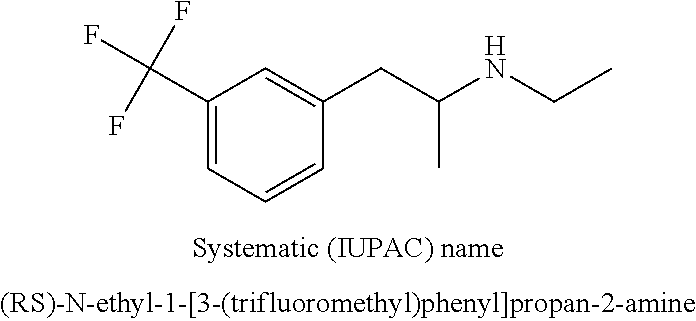Methods of treating doose syndrome using fenfluramine
a technology of fenfluramine and doose syndrome, which is applied in the field of human patient treatment, can solve the problems of clinically unpredictable myoclonus in multiple parts of the individual's body, ineffectiveness against others, and worsening the frequency and severity of seizures, so as to prevent and/or improve seizures in the subject.
- Summary
- Abstract
- Description
- Claims
- Application Information
AI Technical Summary
Benefits of technology
Problems solved by technology
Method used
Image
Examples
example 1
Safety and Efficacy of Fenfluramine Hydrochloride Oral Solution in Pediatric Doose Syndrome Patients
[0127]The efficacy of fenfluramine as an add-on treatment in children diagnosed with mycolonic atonic epilepsy (Doose syndrome) is studied in a Phase 2 Clinical Trial.
Trial Objectives, Design, and Overview
[0128]An open-label, non-randomized non-placebo controlled add-on study is designed to assess the efficacy and safety of low-dose add-on fenfluramine on children diagnosed with myoclonic atonic epilepsy (Doose syndrome) experiencing seizures refractory to standard therapies. Oral formulations of fenfluramine are administered across a range of fenfluramine doses (0.2, 0.4, and 0.8 mg / kg / day, to a maximum of 30 mg / day). The trial is conducted over a 14-week period with responders eligible for participation in an open-label extension. Parents / caregivers use a daily diary to record the number / type of seizures, dosing, and use of rescue medication.
[0129]The 6-week Baseline Period consists...
PUM
| Property | Measurement | Unit |
|---|---|---|
| Weight | aaaaa | aaaaa |
| Mass | aaaaa | aaaaa |
| Mass | aaaaa | aaaaa |
Abstract
Description
Claims
Application Information
 Login to View More
Login to View More - R&D
- Intellectual Property
- Life Sciences
- Materials
- Tech Scout
- Unparalleled Data Quality
- Higher Quality Content
- 60% Fewer Hallucinations
Browse by: Latest US Patents, China's latest patents, Technical Efficacy Thesaurus, Application Domain, Technology Topic, Popular Technical Reports.
© 2025 PatSnap. All rights reserved.Legal|Privacy policy|Modern Slavery Act Transparency Statement|Sitemap|About US| Contact US: help@patsnap.com



